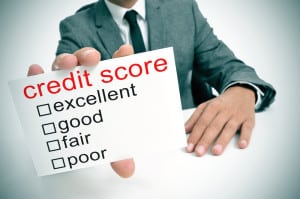People are often confused by the credit scoring system. What you should know is that there are several different credit scoring  models used by the various credit reporting agencies, and your credit score is viewed differently by different types of lenders.
models used by the various credit reporting agencies, and your credit score is viewed differently by different types of lenders.
For example, when a mortgage lender looks at your credit profile, they will usually run a “tri-merge” credit report, meaning that they will query the three primary credit reporting agencies (Trans Union, Equifax, and Experian). Knowing that credit reports are typically inaccurate (up to 25% per this US News & World Report Article), they typically discard the highest and lowest credit scores, and use the middle score. For example, if the three bureaus report your scores as 619, 680, and 705, they would drop the highest and lowest score, and rate your mortgage application using the 680 score.
If you are applying for a car loan or other type of credit, the credit scoring system is a bit different.
As far as what a good credit score is, I’ve detailed below the different levels of credit worthiness using a generic model. Using this model, you can see that a “good” credit score is anything above 680, and the higher the score, the better the terms are for you when applying for financing.
- Excellent (800+) – Regardless of the scoring model, a credit score of over 800 is excellent and you should qualify for the best available interest rates and terms on most loans.
- Great (720-799) – I often refer to the mortgage industry, and 720 is the starting point for what is considered Top Tier credit and can get you excellent rates and terms.
- Good (680-719) – In this range, most lenders would consider you a good credit risk, including loans for business purposes.
- Fair (620-679) – This indicates that you have had some credit challenges, whether it’s late payments, high balances, or recovery from a foreclosure or bankruptcy. You would most likely be approved for a home mortgage here, but you may not get the best rate or terms due to some perceived risk by the underwriter.
- Poor (580-619) – At this level, you would be considered a higher than normal risk, so you might be looking at getting loans from non bank / non traditional lenders that charge higher rates.
- Bad (501-580) – With a credit score of under 580, you would be having more trouble getting lenders to approve your financing, unless there is some security like a large down payment or perhaps a co-signer on a loan. This is an area where you might find a sub prime (i.e. high risk, high cost) lender willing to loan you money, but you need to consider whether or not it’s worth taking a loan if the terms are unfavorable. Sometimes waiting is well worth it.
- Horrible (< 500) – It is doubtful that you would qualify for financing with a credit score.
The good news is that if your credit score isn’t as good as you want it to be, you can always improve your credit score.
Stay tuned for the next several blog posts in the Sound Credit Series, where I will discuss:
- How to get your free credit score
- How to get a copy of your credit report (for free)
- How to repair your credit and increase your credit score
- How to find a trusted credit repair company
If you are at the top of the credit score chart, congrats! If not, we will get you there soon enough.

Pingback:
Notice: Only variables should be assigned by reference in /home/u695681943/domains/fiscallysound.com/public_html/wp-content/plugins/subscribe-to-comments/subscribe-to-comments.php on line 590
How to Get Your Free Credit Score | Fiscally Sound